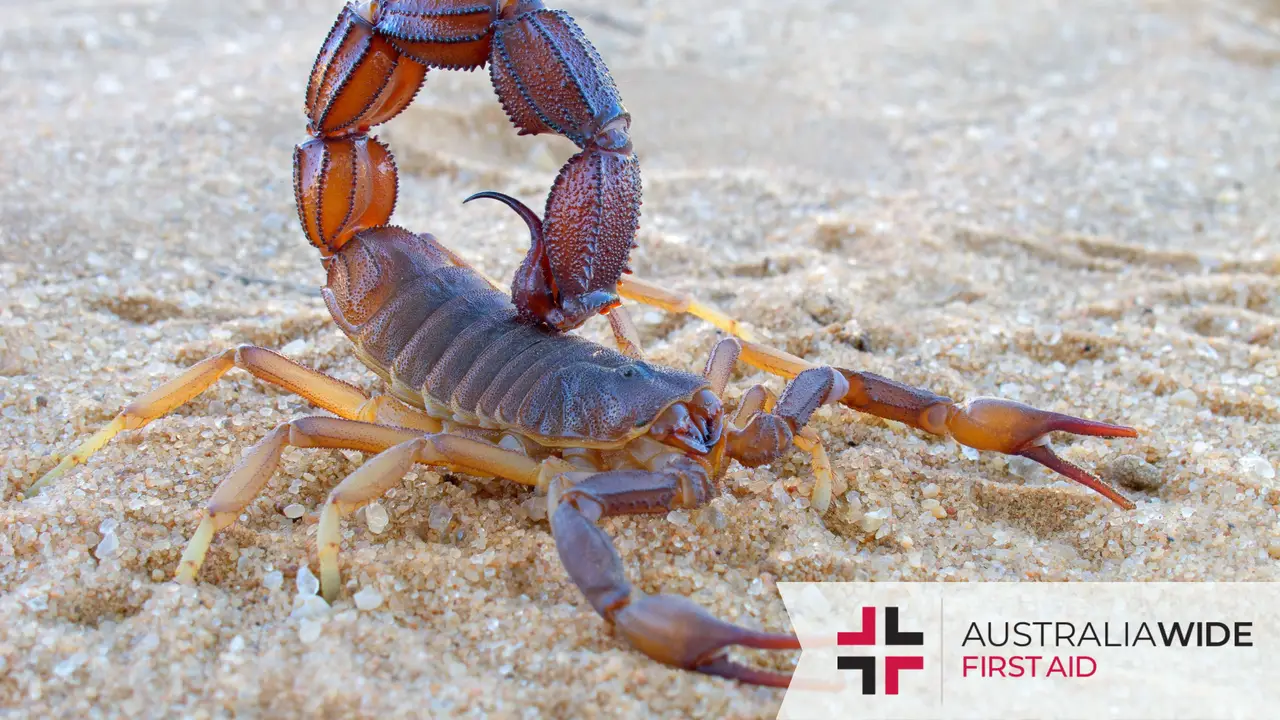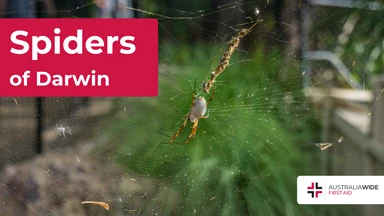Scorpions in Australia: What They Look Like and Where They Live


Here in Australia, we are renowned for our venomous snakes and spiders. But did you know we are also home to a wide variety of scorpions?
Scientists estimate we could have more than 100 species of scorpions!
They have even been known to enter homes, where they can inflict painful stings.
If you’d like some hands-on experience dealing with bites and stings, you can attend one of our general or childcare first aid courses. We have training locations across most places in Australia.
Scorpions are unique creatures that are easily distinguished by their long, curved tails, which feature a stinger at the end. They also have two pincers that are situated at the front of their body.
Australian scorpions can be anywhere between 2 to 12 cm long.
Although they have multiple eyes, they don't have the best eyesight. They can still distinguish light from dark and have exceptional low light sensitivity, which helps them to navigate by moonlight or starlight and avoid harsh sunlight.
To move around, scorpions rely on their sensory hairs, slit organs, and pectines, which are located on their legs (pedipalps) and body, respectively. These structures allow scorpions to pick up vibrations, scents, and ground textures.
Additionally, scorpions breathe through four pairs of book lungs, which are situated on the underside of their abdomen.
Female scorpions tend to be heavier and more robust than males, with shorter tails.
Their coloration can range from dark grey to light brown or gold, with lighter-coloured legs.
Interestingly, scorpions can fluoresce under ultraviolet light, which scientists use to observe them in the wild. This fluorescence is thought to be an ultraviolet sensitivity mechanism that helps scorpions avoid damaging light levels.
A few common species you might come across in parts of Australia include:
Scorpions are common arachnids found in a variety of habitats throughout Australia. They are found under logs, rocks and in shallow burrows in earth banks.
They can be found almost anywhere in Australia, but because they typically live in remote habitats and are nocturnal, they aren’t seen very often.
Scorpions are nocturnal, and hunt during the night.
Most scorpions ambush their prey that forage at or in the vicinity of their burrow, but some are more active foragers. They typically feed on anything that is smaller than them, including beetles, cockroaches, spiders, slaters, centipedes, and millipedes.
Their main predators are lizards, nocturnal birds, other scorpions, marsupials, and rodents.
A female scorpion will carry her young on her back for a few days or weeks, before they then leave to find food and shelter.
Scorpions take a long time to reach maturity, and will moult frequently – up to six times over two to six years.
They can live for up to ten years, though some species have been recorded as living up to twenty five years.
Australian species of scorpions have a potent sting that can cause inflammation and pain for several hours. If you are stung by a scorpion, apply a cold pack to the affected area. Seek medical attention if the pain persists.
It is important to note, no Australian scorpions are known to have fatal venom, and victims of their stings don’t typically need medical assistance.
To prevent scorpion stings, wear protective clothing like gloves and shoes when working in the garden, and keep floors in the house and garage clear of clutter and debris.
You can also reduce insect habitats by covering compost and garbage, and by removing building materials around the house.
While you’re unlikely to come across a scorpion in Australia, it’s far from impossible.
Even though Australia has no deadly species of scorpions, a sting from one can still be very painful. If you’re stung and are concerned, or the pain is lasting longer than a few hours, seek medical advice.
If you’d like some hands-on experience dealing with bites and stings, you can attend one of our general or childcare first aid courses. We have locations across most places in Australia.

March 11, 2025
Darwin, the tropical capital of Australia’s Northern Territory, is home to a rich diversity of wildlife - including an impressive array of spiders. From the sprawling webs of golden orb-weavers to the cryptic camouflage of trapdoor spiders, these arachnids play a vital role in the local ecosystem. While some may inspire fear, the majority are harmless and even beneficial, helping to control insect populations.

September 4, 2024
Cat bites, while often underestimated, can lead to serious health complications if not treated promptly and properly. Cats' mouths harbour a variety of bacteria that can cause infections in humans.

April 1, 2024
Encounters with wildlife can often be thrilling, but when it comes to the creature known as the drop bear, the experience can quickly turn dangerous. A sharp increase in recent attacks prompts the need for understanding proper first aid procedures in case of an attack.